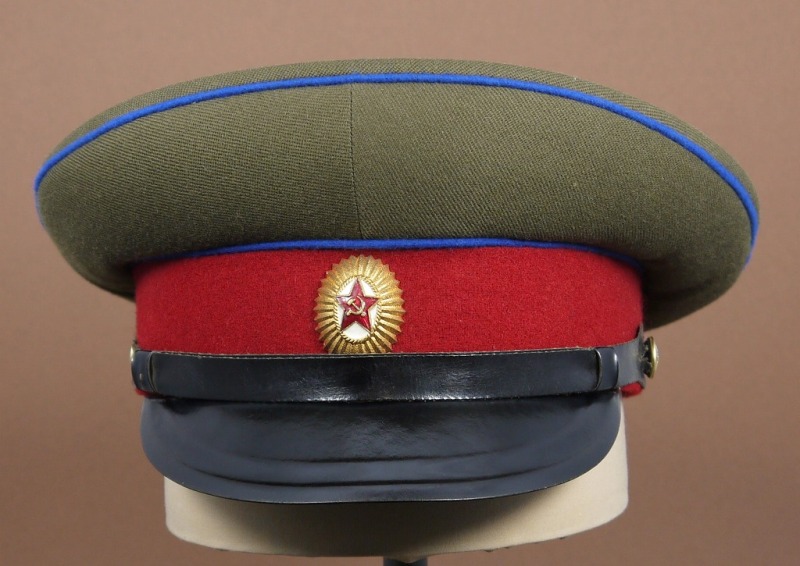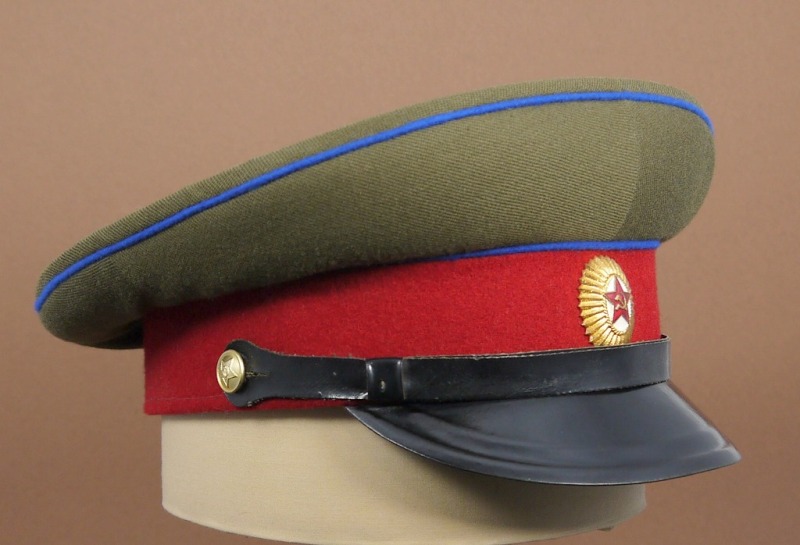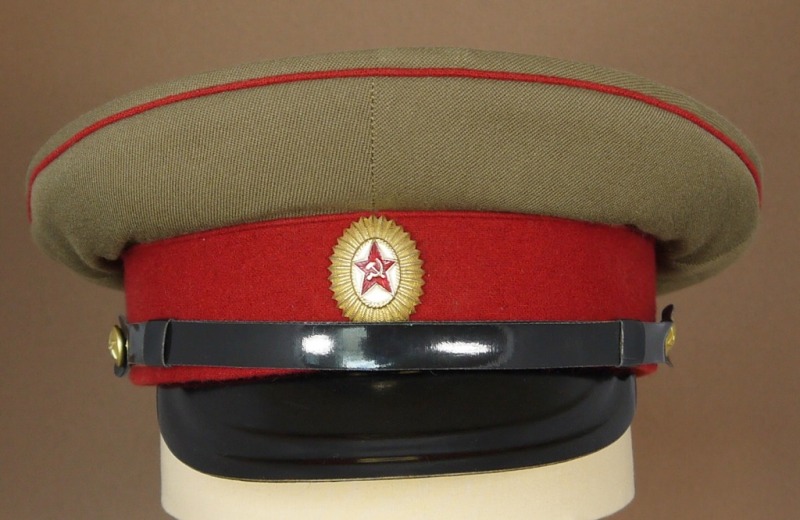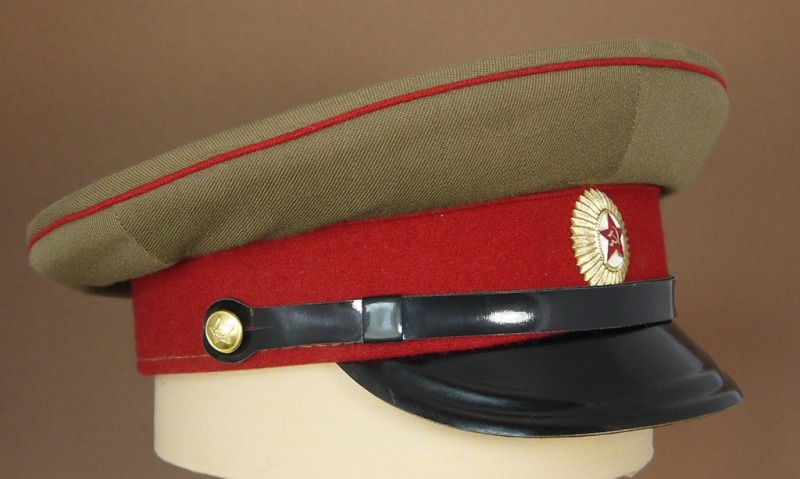 Caps of the Soviet NKVD/MVD/NKGB/MGB
Caps of the Soviet NKVD/MVD/NKGB/MGBIncluded here are caps worn by officers and men of the Soviet NKVD and its 1946 successor, the MVD. The NKVD (or Peoples Commissariat for Internal Affairs) was the infamous Soviet Secret Police of the 1920's, 30's and 40's. Under such notorious commanders as Lagoda, Yezhov and Beria, they rounded up accused dissidents and escorted prisoners to the GULAG. They also lined the sides of Red Square during state funerals and military parades and, when formed into more conventional military units, backed up Red Army troops to ensure they did not retreat, operated as "blocking detachments" and conducted anti-guerrilla operations in re-conquered Soviet territories in WWII.
NKVD/MVD and state security organizations were constantly reorganized, resubordinated and renamed in the years following WWII. Republics at one time controlled MVD forces on their soil before they returned to "all-union" control in 1966 (although under the title Ministry of Public Order (MOOP) until 1968 when they again were called MVD).
In the first decades following WWII, the major uniformed elements of the NKVD/MVD consisted of internal security and convoy protection (prisoner movement) troops. However, other sizable uniformed elements included fire protection troops, key facility and lines of communications' guards, emergency response, prison guards and a host of supporting administrative, logistical and criminal investigative personnel. The internal security troops (reorganized and renamed the Internal Troops (Vnutrennaya Voiska - VV) in 1968) were arguably the most significant of these forces - forming the main armed security force of post-war USSR. Organized into Army-style units (up to division in size) and equipped with heavy weapons including tanks, artillery, and armored personnel carriers, the VV's primary peacetime mission was to safeguard public order and quell serious internal unrest that regular police were unable to handle due to lack of training, manpower or heavy weapons. Wartime missions included securing occupied areas, policing friendly rear areas in conjunction with the militia and handling prisoners of war. Although ranks and insignia varied between the VV and the other MVD "organs", all these personnel - with the exception of the militia (police) - wore the same basic military-style uniforms. The singular exception to this was the 1969 regulation that required VV generals to wear Army-style uniforms (which I discuss near the bottom of this page).
While most commonly associated with the NKVD/MVD, personnel of the Main Directorate for State Security (GUGB; 1934-1941) and its later transformations as the NKGB (People's Commissariat for State Security) and MGB (Ministry for State Security) wore the same blue-topped caps as their NKVD counterparts until 1954. At that time the MGB transitioned into the KGB and adopted the cornflower-blue banded and piped caps shown on my KGB page.
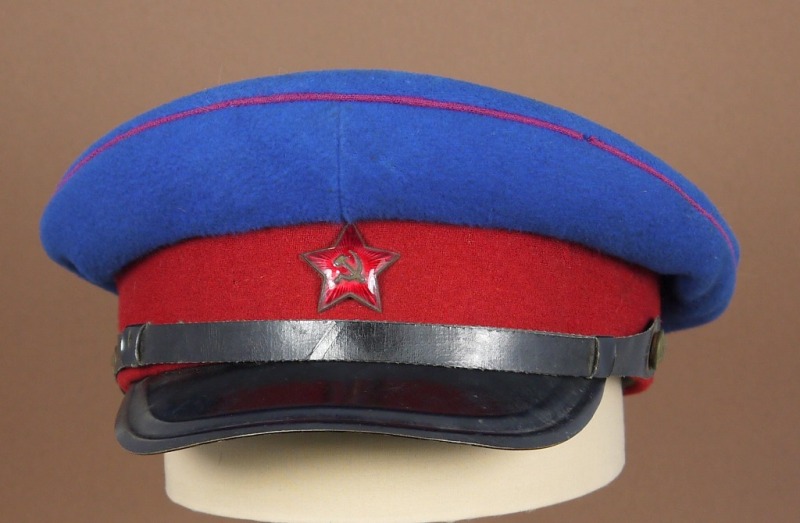
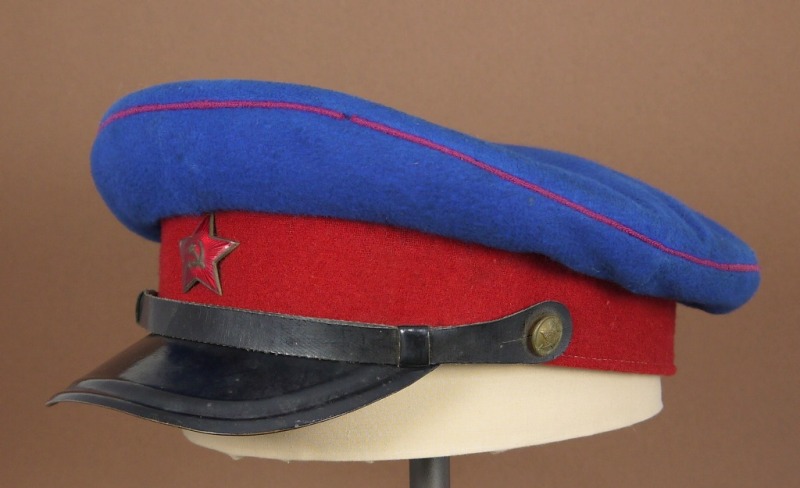 NKVD/MVD/NKGB/MGB
NKVD/MVD/NKGB/MGBOfficer/Soldier Service/Parade
1939-1954
This cap remained unchanged from 1935 (when the spade-shaped visor became standard) until the blue topped caps were abolished in 1954.
Only the one-piece brass coated steel and enamel star and internal markings date its manufacture probably to post-1938.
The cap top is in "cornflower" blue napped wool - first adopted by convoy troops of the GPU (a component of the NKVD at the time) in 1923/24 as its defining uniform color - thus resulting in the nickname "blue tops" among the Soviet population.
The band of these caps was rust brown/maroon (in Russian, the name of this color translates as nettle) and the piping is magenta. However, it takes a close look to differentiate the difference between these last two colors.
Above the squared-off (or spade-shaped) fiberboard visor is a normal black oilcloth strap held in place by two stamped Army-style gilt buttons (heavily tarnished in this case).
All officers and enlisted personnel wore this same cap for both everyday and parade duties. Note the crown is relatively small - both in circumference and in height - which was standard for caps produced before 1969.
Rare
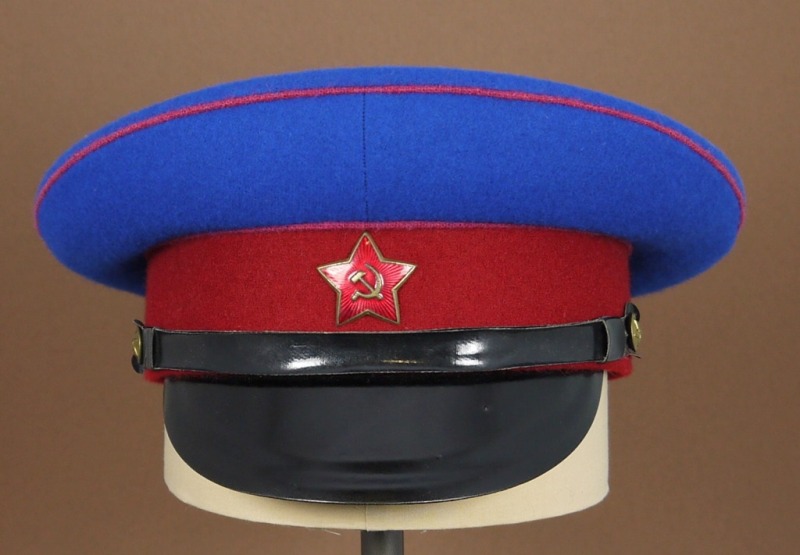
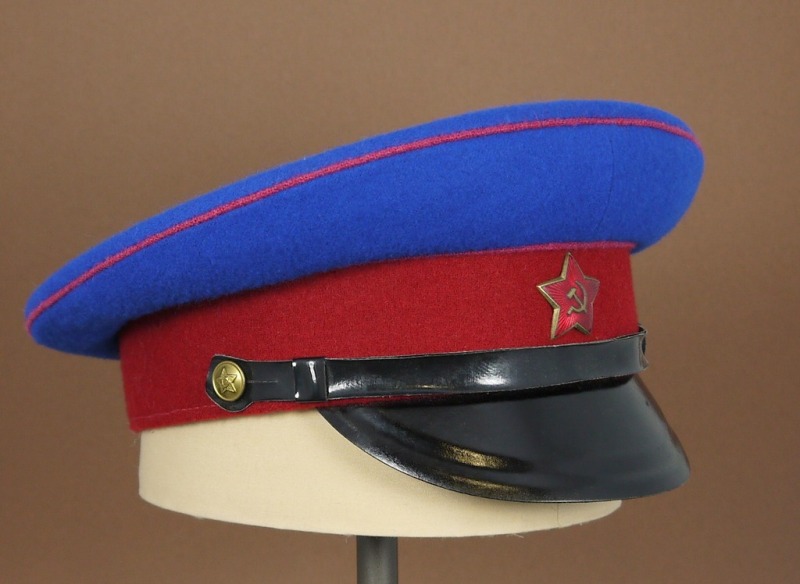 NKVD/MVD/NKGB/MGB
NKVD/MVD/NKGB/MGB
Officer/Soldier Service/Parade
1935-1954
A variant of the above cap - similar in all aspects except the visor is semi-circular. It too, has the relatively small napped wool cornflower blue crown with rust brown band and magenta piping.
It also has a 1939 or 1947 style one-piece star, black oilcloth strap and stamped metal buttons. Although the rounded fiberboard visor did not officially replace the spade-shaped until 1954 (the same year the blue-topped cap was abolished),
a small percentage of caps from the 1930's and 40's were manufactured with rounded visors. However, it does probably indicate manufacture just before this cap was phased out.
Rare
| I am fortunate enough to also own a early model OGPU (Joint State Political Directorate - the successor to the Cheka and precursor to the GUGB/NKGB) cap dating from the early 1920's. When compared to the previous two caps, it nicely illustrates the evolution of Soviet visor cap design. The colors are the same, but notice the very small size (circumference and height) of the crown. This reflects the Soviet military style popular in the 1920's (I have a number of cavalry caps from that time period made the same way). The visor, too, is much smaller than later models. It is made of black-lacquered enamel and is semi-circular in shape - which was standard before 1935. The black strap is non-standard and may be German or Austro-Hungarian. It is held in place by two sewn-on black-painted Red Army buttons; the use of which again dates from the 1920's. The star is made of stamped copper with a separate hammer and sickle emblem attached by pins. Instead of being hot-enameled, the red on the star is simple paint. Use of such stamped and painted Soviet stars is consistent with troops being locally outfitted rather than being clothed from central facilities. The lining is simple cloth - with a manufacturer's and a unit stamp. Finally, notice the sweat band. It is made from a very course burlap-type material, a feature I've seen on a number of Czarist Russian soldier caps manufactured in 1917/1918. |
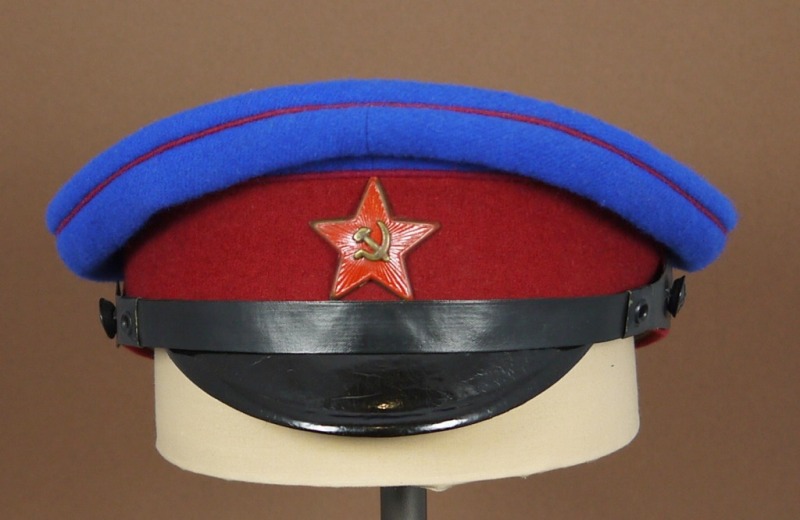
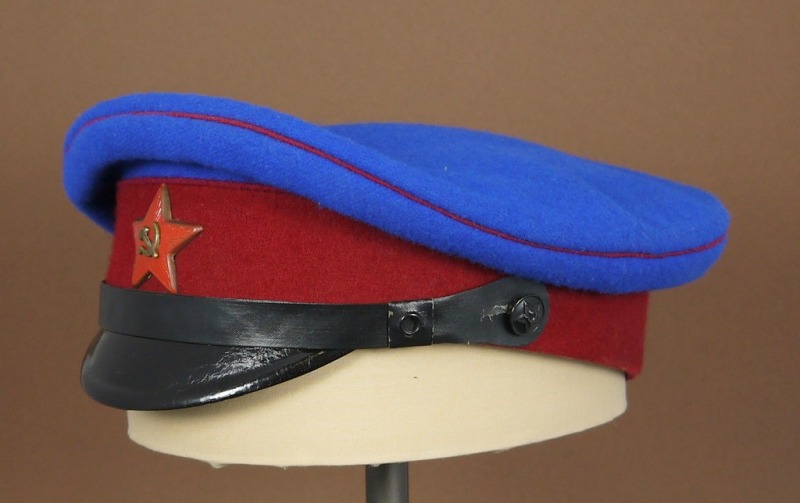
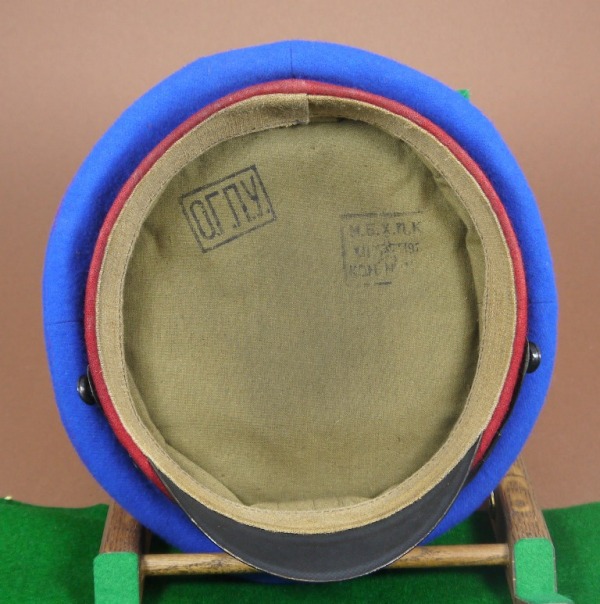
|
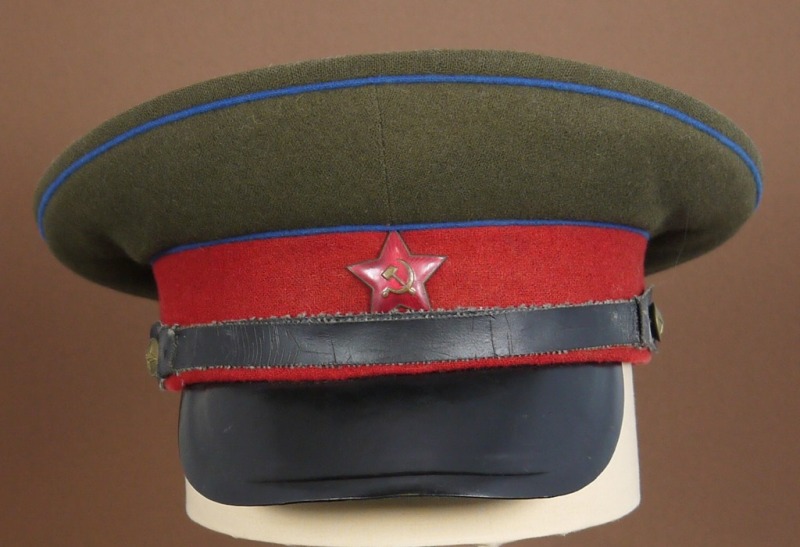
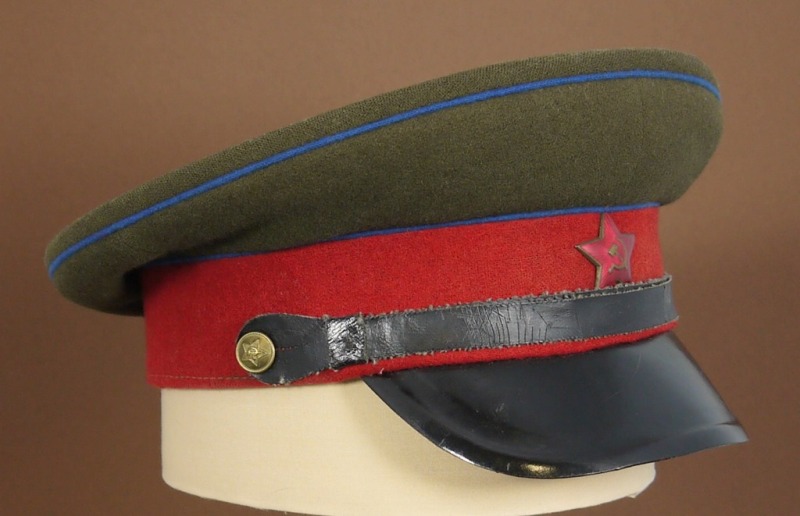 MVD
MVD
Sergeant/Soldier Parade/Service
1955-1969
This cap would have been worn by a sergeant or conscript soldier of the MVD Internal Troops. It is the successor to the blue-topped caps worn by the NKVD described above.
Following the breakup of the NKVD into the MVD and KGB, each of those organizations selected a unique cap color scheme. The MVD retained the rust brown (nettle) band but exchanged magenta piping for cornflower blue. The crown is now in a khaki wool blend material. This same cap was worn for day to day service and for parade.
The enameled metal star identifies this as belonging to a sergeant or soldier. Two-piece stamped metal Army-style buttons hold the black oilcloth strap in place above the
spade-shaped fiberboard visor. Although the Ministry of Defense officially replaced its spade-shaped visors by semi-circular ones in 1954, the MVD and other paramilitary organizations typically took 6 - 12 months to follow suit on uniform changes.
This indicates this particular cap was produced in 1955-1956.
Rare
This 1964-dated cap was worn by officers - colonels and below - for everyday service until replaced by the 1969 model without blue piping.
It is similar to the previously described enlisted style cap but with a M55 officers' cockade - made of tombac and hot enamel. The visor also differs in that it is semi-circular in shape, matching that approved for the Ministry of Defense in 1954.
The oilcloth strap and Army-style buttons are standard.
Scarce

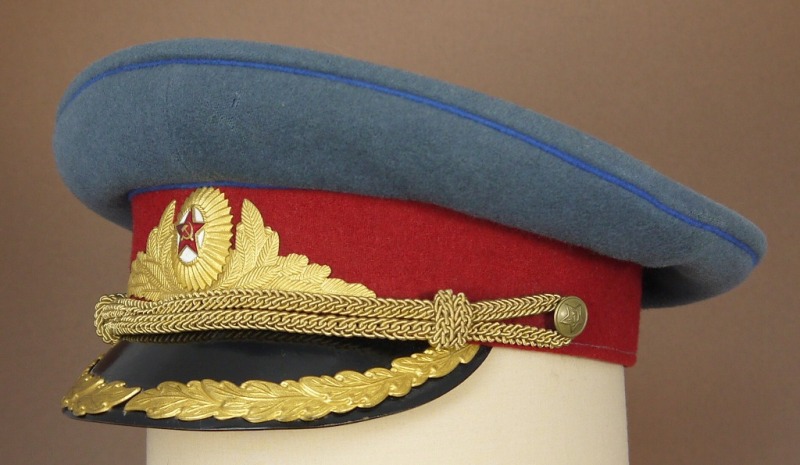 MVD
MVD
Officer Parade-Walking Out
1955-1957
The counterpart to the Army "Zhukov" style uniforms described on my Army 1955-1957 page.
MVD regulations of 1956 mirrored the 1955 uniform regulations of the Ministry of Defense, which resulted in adopting a medium gray (steel) officer parade uniform.
The new cap had a gray crown but in common with other MVD caps of this period the band remained rust brown and all piping was in cornflower blue.
A two-part emblem consisting of the new M55 oval officers' cockade attached to a brass stamping of simulated laurel leaves was pinned through the band.
Metal leaves were also pinned through the semi-circular fiberboard visor.
To further decorate this cap, gold-colored filigree cords were wore in place of the black chinstrap.
Rare
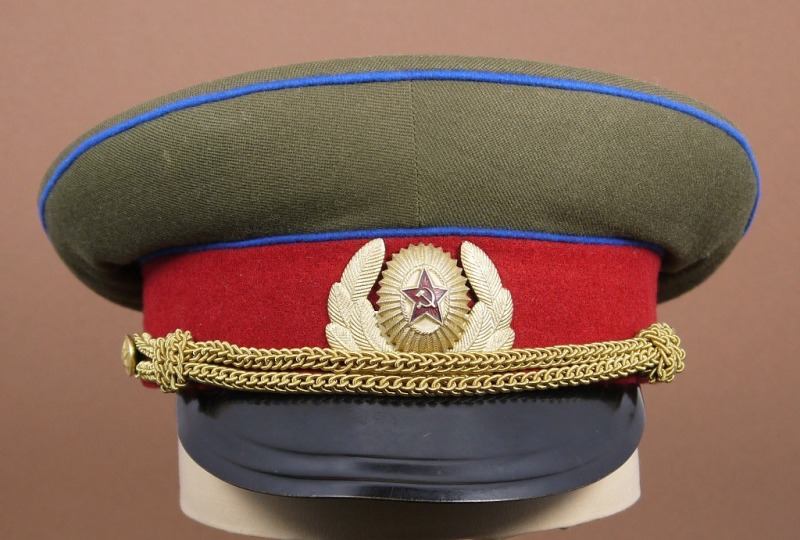
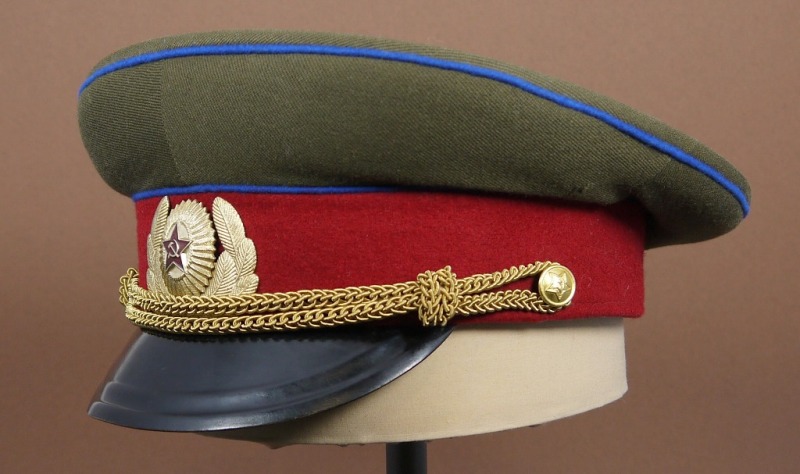 MVD
MVD
Officer Parade-Walking Out
1959-1969
This cap replaced the previously described gray-topped one for officer parade/walking out wear in the 1959 MVD uniform regulations.
As I discussed on my Army 1955-57 page, following Marshal of the USSR Zhukov's ouster as Defense Minister in 1957, new, less ornamental officer parade uniforms
were introduced. This cap reflects that trend. The only two features differentiating it from the already existing officer service cap was the retention of the
gold cords of the "Zhukov" cap and the use of the new M58 officers' parade cockade and emblem. This was in two pieces,
with a M55 oval cockade attached to a separate stamped metal piece depicting 10 laurel leaves (5 per side). After 1968 this same cockade/emblem combination was produced in a single aluminum piece
worn only by Air Force officers. As you can see, the crown is back to traditional Soviet khaki, while the band and piping are rust brown and cornflower blue respectively.
The visor remains black lacquered fiberboard and two-piece metal buttons hold the cords in place.
Scarce
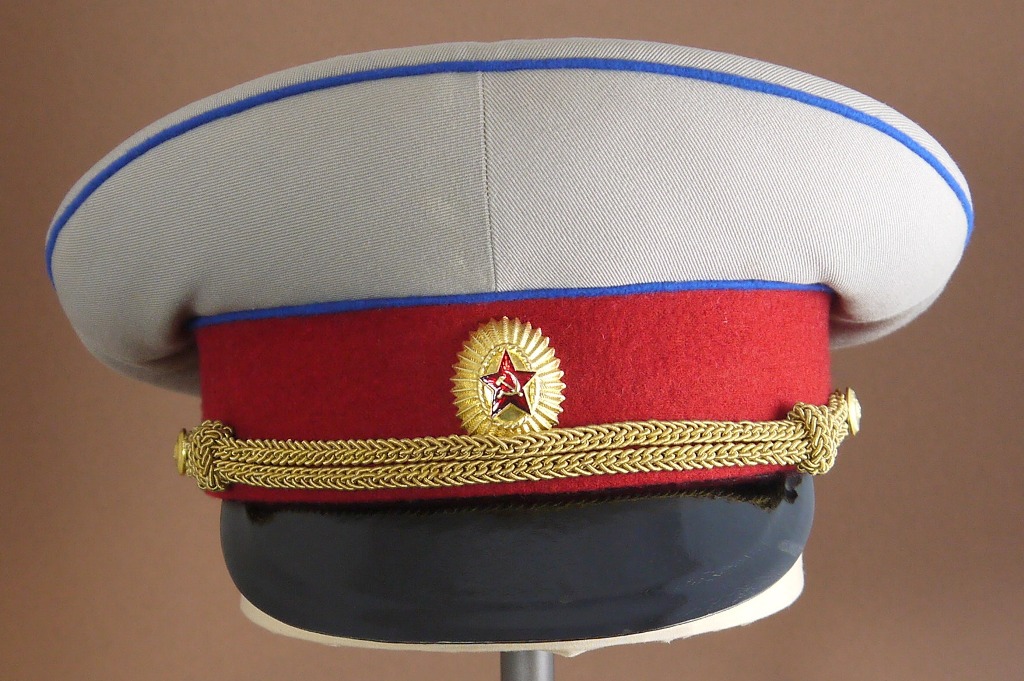
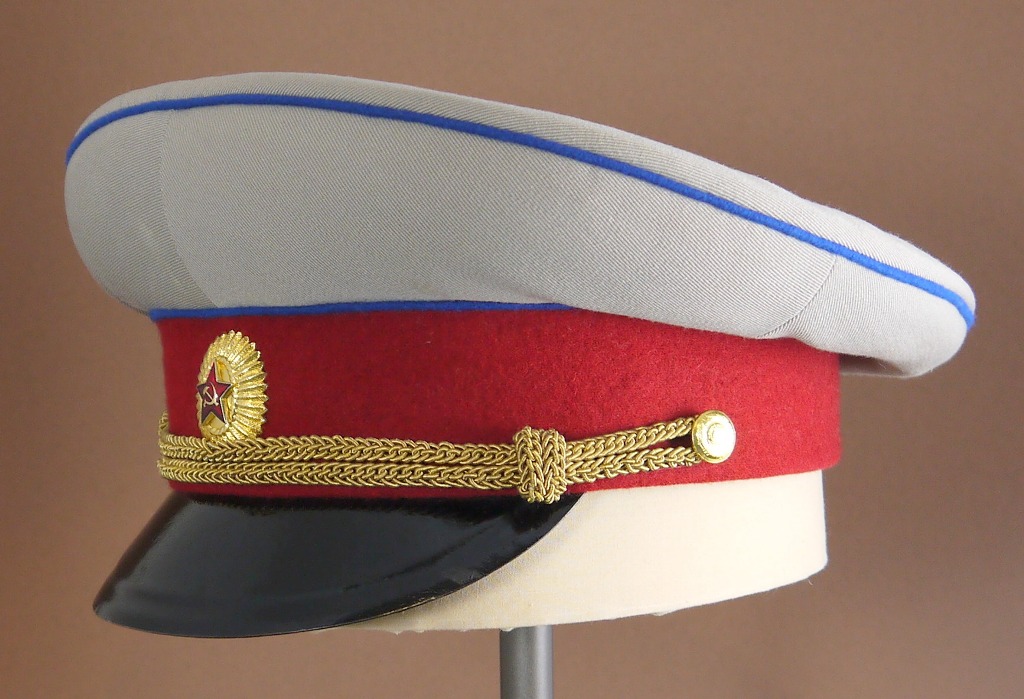
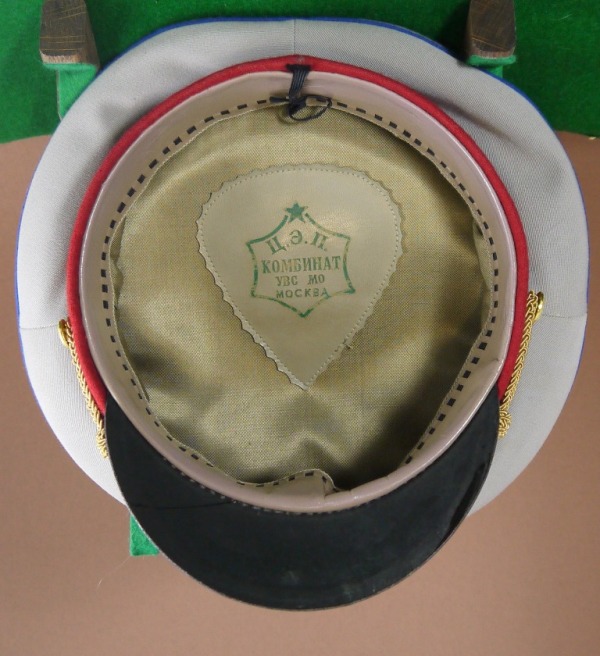 MVD
MVD
General Summer Service
1956-1969
One of the rarest caps in my collection. This seldom-seen cap was worn by MVD generals with a matching light gray jacket as part of the summer service uniform. It remained in use from 1956 until MVD colors were simplified in 1970.
The crown of the cap is sewn from fine light-gray gabardine fabric while the wool band is standard MVD "nettle."
The crown is piped in cornflower blue, which was standard until replaced by the same red-brown used on the band in November 1969. It has a rounded fiber-board visor with gold cap cords held by two gilt general-grade buttons (with stamped Great Seal of the USSR).
The cockade is the 2-piece, all gilt, general's model with no white enamel. Standard general-quality interior elements include a silk lining and a kid-leather sweatband with a interwoven silk ribbon.
Very Rare
After the Army introduced new service and parade uniforms in July 1969, the MVD was extended the right to wear matching military uniforms in November 1969; with only the secondary (branch) color being different.
This 1969-dated cap was thus one of the very first created in the MVD's new simplified color scheme - with both band and piping now in rust brown (nettle).
The size of this cap's crown matches that of earlier models (smaller in both circumferance and height than post-69 models), indicating the factory continued to manufacture to
old size specifications even as it switched to the new color scheme. For the first few years, regulations called for officer and extended serviceman every-day caps to have black chinstraps as shown here. However, in 1975 gold cords replaced black straps on all officer caps (except for warrant officers).
A standard - now aluminum - M55 officer's cockade is mounted to the band and stamped metal buttons hold the strap above the fiberboard visor.
Scarce (with pre-69 size crown); Available (post-69)
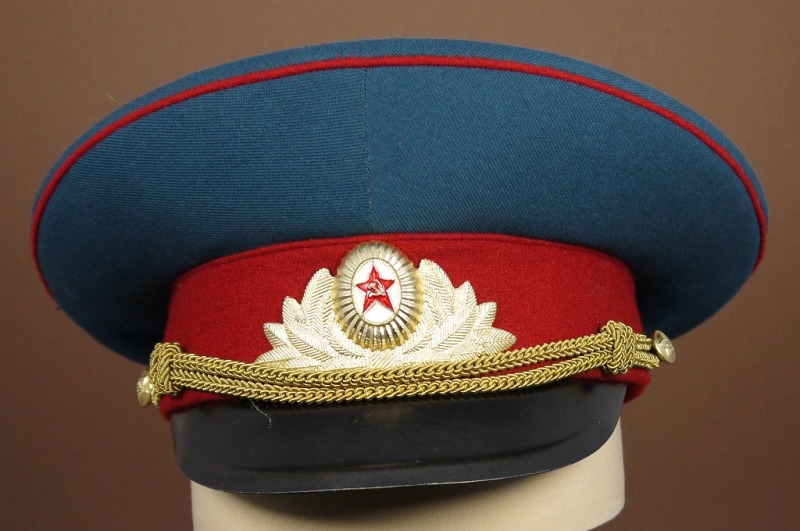
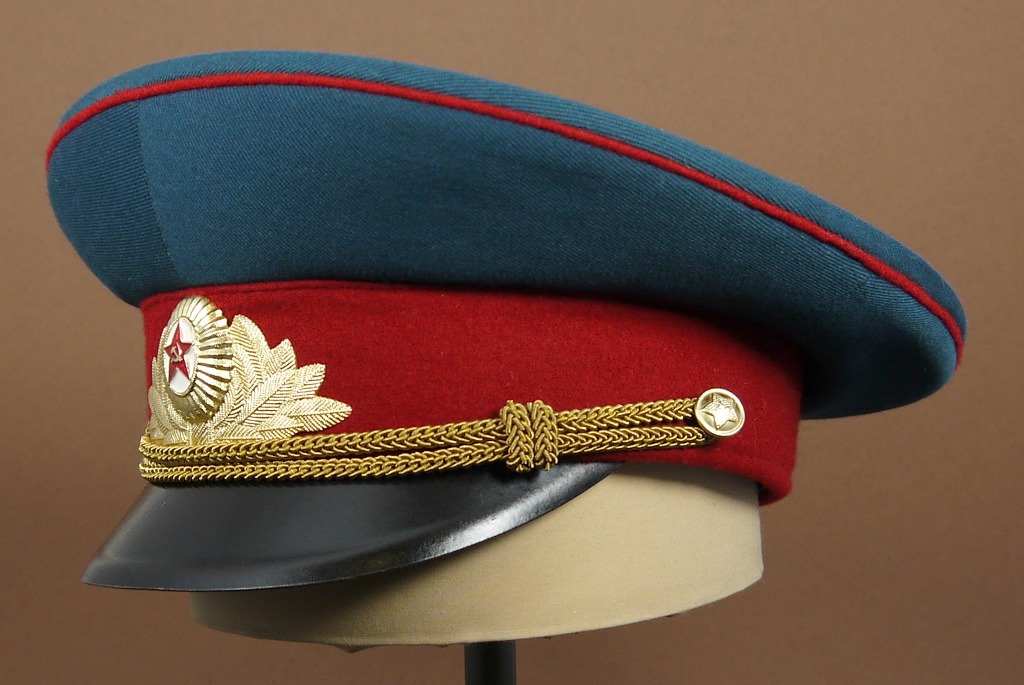 MVD
MVD
Officer/Extended Serviceman Parade-Walking Out
1969-1991
New bluish-green ("wave") parade uniforms were also approved in 1969; mirroring those of the Army. All officers (colonel and below) and extended servicemen and sergeants wore the same cap - as shown here.
Notice the crown is larger than the previous cap - displaying the typical M69 design. Band and piping remain rust-brown. The new one-piece M69 parade cockade (with 18 stylized laurel leaves) is pinned through the band
above gold filigree cords. The visor of this 1979-dated cap is still black lacquered fiberboard - although plastic started to replace this visor material in the mid-1980s.
Available
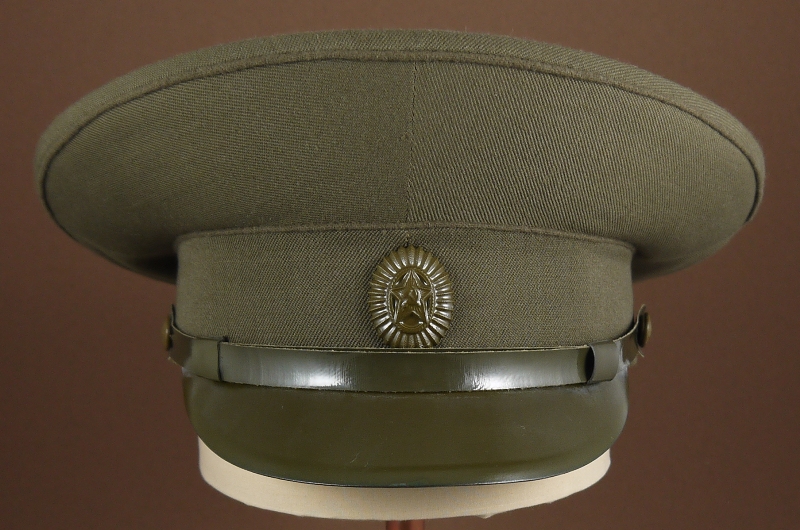
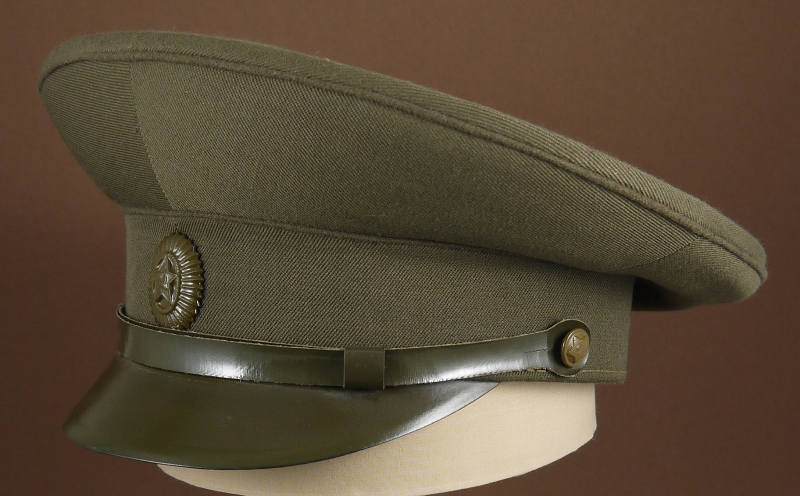 MVD VV
MVD VV
Officer Field
1969-1988
For duties in the field or wartime, MVD internal security (and after 1968 - VV) officers were authorized a khaki cap identical in all respects to their counterparts in the Army. Shown here is a post-69 version; field caps produced from 1958-1969 had smaller crowns. It has a green oilcloth chinstrap and green painted buttons, cockade, and fiberboard visor. Piping is khaki, not rust brown. Wear of the visored field cap was stopped in 1988, when officers switched to wearing a color-piped pilotka or a new-design soft field cap in the field.
MVD internal security generals were also authorized to wear an all-khaki cap from 1958 until 1969. Thereafter, VV generals wore the same red-piped field cap as Motorized Rifle generals.
Available
MVD
Conscript/Cadet Parade-Walking Out
1969-1991
New uniform regulations introduced in 1969 also completely changed parade/walking out uniforms for conscripts (any soldiers/sergeants who were NOT on extended service) and cadets at MVD officer commissioning schools. This uniform remained khaki but now had an open-collar jacket worn over a shirt and tie. The accompanying cap did not change much in overall appearance, but the crown was enlarged and a new wreathed cockade replaced the earlier plain red star.
The cap shown here was probably manufactured in the late 1970s - since it has a small, two-rimmed plastic visor vice the larger, one-rim plastic visor which became common in the 1980s. The crown is khaki while both band and piping is in
rust-brown "nettle" wool. The conscript's parade cockade is a one-piece anodized aluminum stamping with a red lacquered star. A black plastic/oilcloth chinstrap is held in place by standard Army-style two-piece gilt buttons.
Available
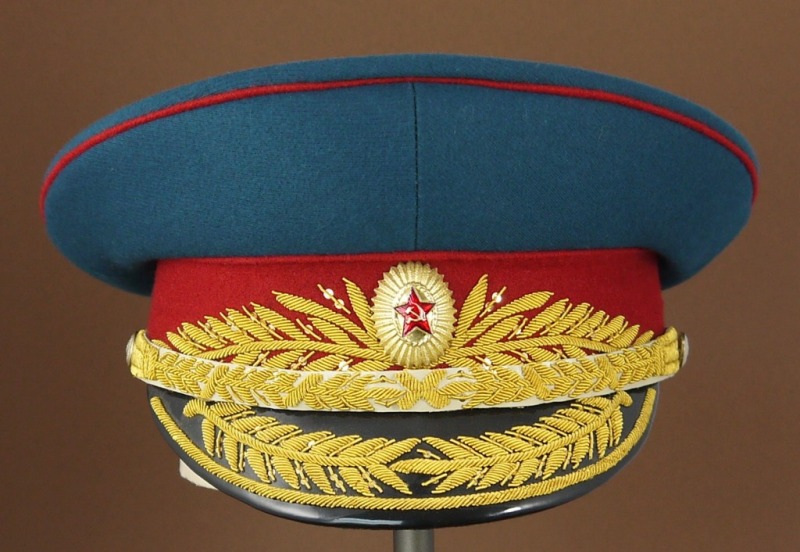
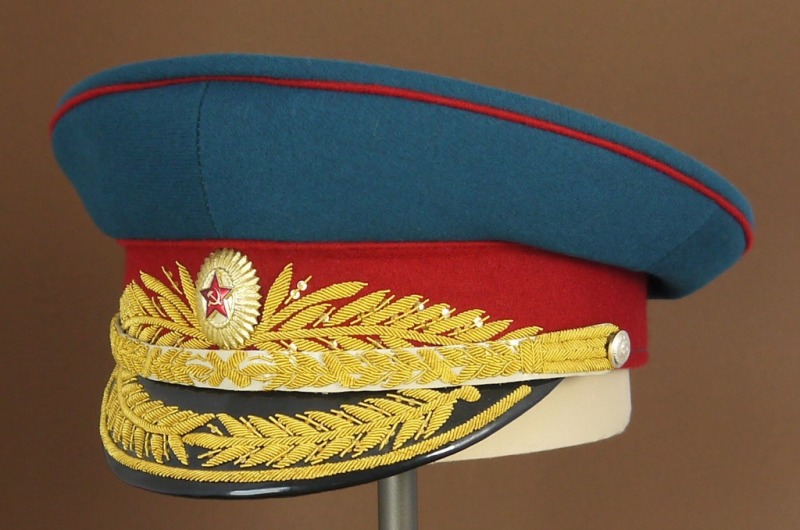 MVD
MVD
General Parade-Walking Out
1969-1991
As with Army generals, MVD generals were authorized wave-green parade uniforms as early as 1955, although junior MVD officers had to wait until 1969 for this uniform. The specific combination of wave green crown with nettle-colored band and piping shown here was worn by generals of MVD organs and services from 1969 to 1991. These forces included units and generals assigned to fire protection, facility and lines of communication protection, prison escorts/guards, administrative and logistics. Essentially, all MVD troops EXCEPT the VV and the militia. As with Army generals' caps, this cap has gilt wire laurel leaves embroidered on the band surrounding a general's two-piece all gilt cockade, a patent leather visor with wire embroidery, natural color leather chinstrap with gold wire embroidery, and general officer buttons. Inside, it has the general quality kid-leather sweatband and silk lining.
Concerning availability of this cap - sizable numbers of these were (and are still) made post-1991 for the collectors' market. These replicas are almost always undated (although many of the later authentic ones were also undated) and often have black silk lining and/or golden silk vice gilt wire embroidery on the band and visor. These last two elements are foolproof ways to detect post-1991 replicas.
Rare (but replicas common)
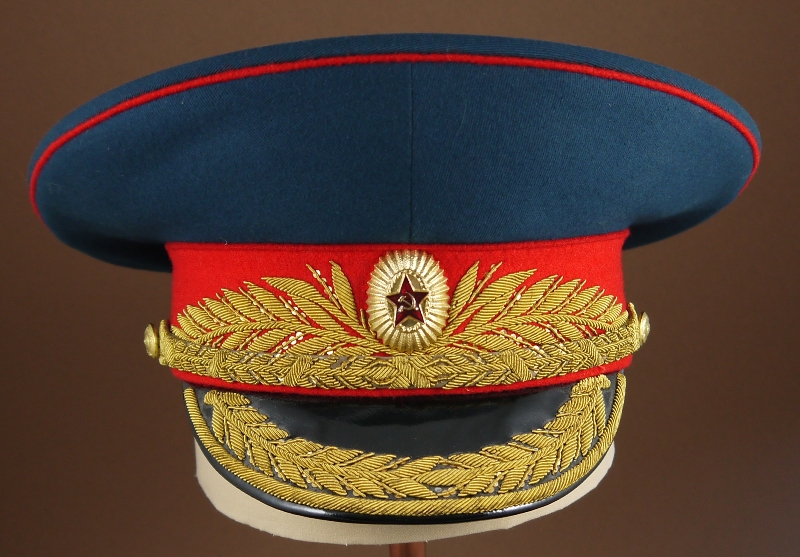 MVD Internal Troops (VV)
MVD Internal Troops (VV)
General Parade-Walking Out
1969-1991
Although not well recognized, according to the 1969 MVD uniform regulations, generals of the Internal Troops (as opposed to the other MVD organizations described for the cap above) wore the same
uniform as Army Motorized Rifle generals. That red banded and piped wave green parade cap is shown here. Service wear included a red-banded khaki cap. You can see a full description of these caps on my
Army 1969-1991 page.
Available
|
To finish my discussion of MVD caps, I've included pictures below of what the M69 service cap morphed into following the collapse of the USSR.
Worn by Russian MVD officers in the late 1990s, this 1996-dated cap retains rust brown piping but otherwise has no other means of distinguishing its owner's service.
This design is actually the second Russian cap evolution since 1991 - with the first having a gray/green ribbon around the band and a Soviet cockade. After a couple years, the ribbon was discarded
in favor of a plain khaki wool band, a new orange/black Russian cockade was adopted, and a double-headed eagle was added to the crown (first version is shown here). The visor is patent leather - vice fiberboard or plastic - which became standard even
for soldiers' caps in the 1990s. The buttons on this caps also changed, replacing the Soviet Army star with the Russian eagle. Notice too, the crown size is even larger than the Soviet M69 style.
The interior shows another way of identifying post 1991 caps - if it has a sewn-in white tag or a "strange" looking sweatband (either color or texture) - it is post-1991.
Russian uniform caps have continued to evolve since 1996 - with both emblems changing and the crown growing to a ridiculous size, before sanity was restored in the 2008 regulations where caps returned to M69-style dimensions and the eagle was dropped from the crown. In fact, current Russian Army and MVD caps look quite similar in shape (but not in color or material) to those in use in 1970. |
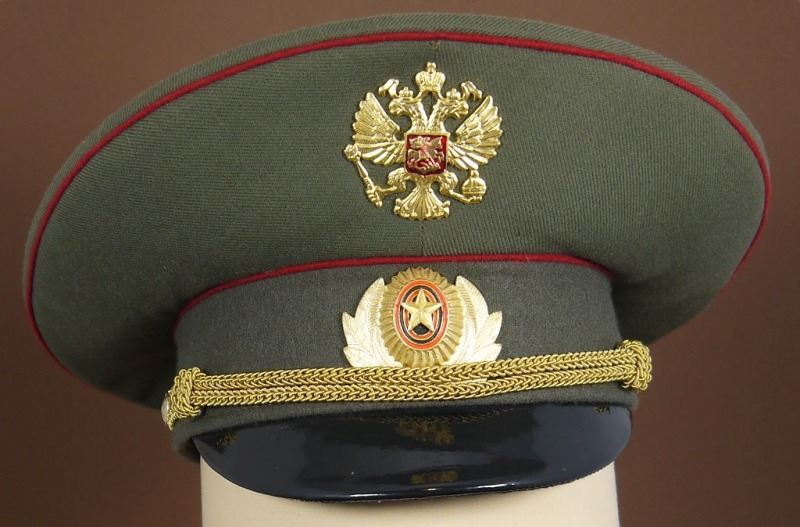
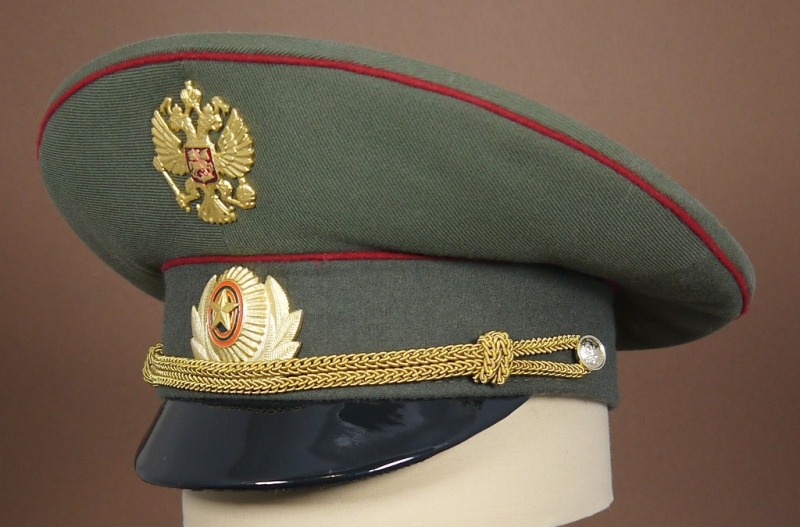

|
